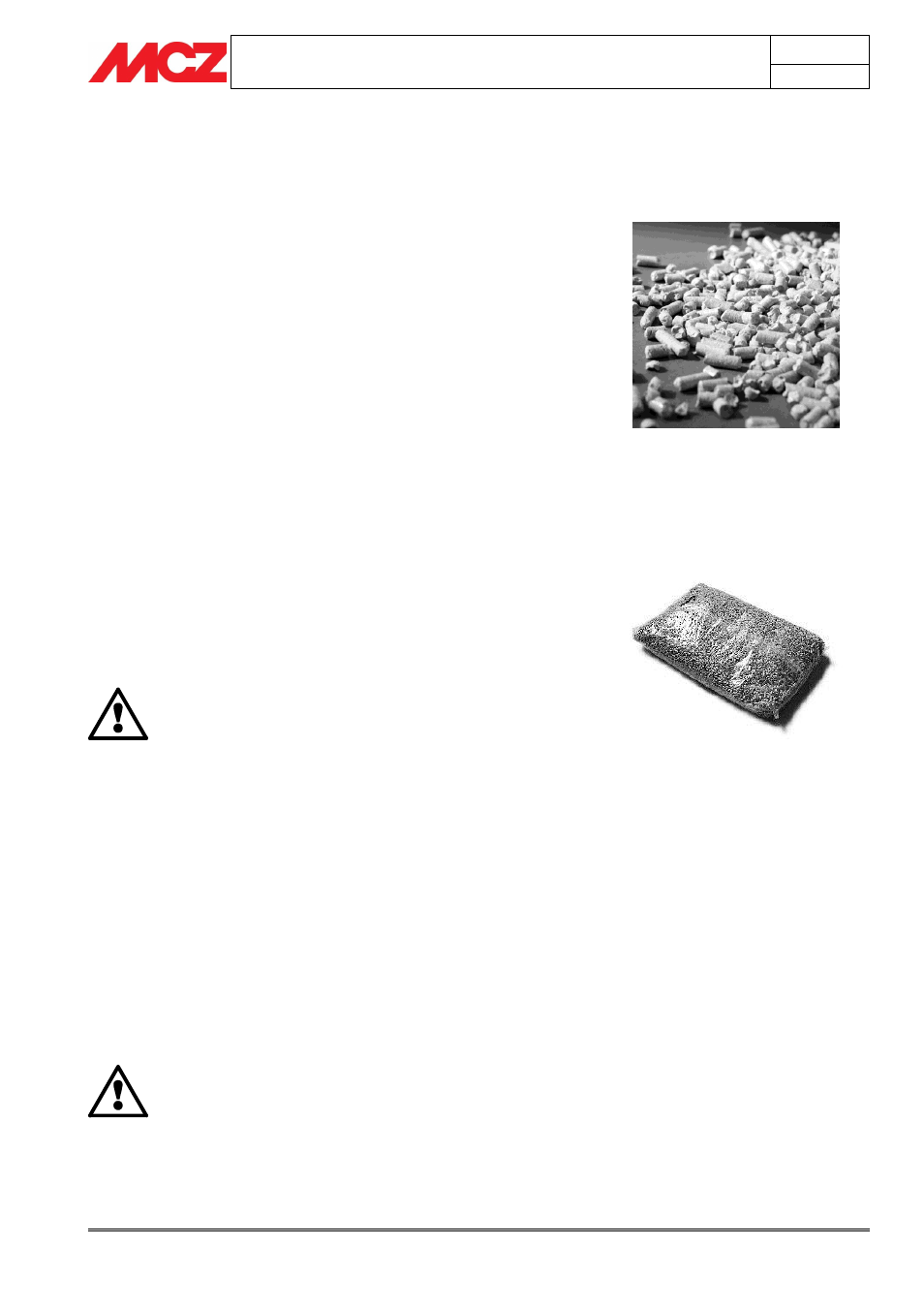Theoretical notions for installation, Pellets – MCZ Club HYDRO 15 kW User Manual
Page 9

PELLET STOVES
Chapter 2
INSTALLATION AND USE MANUAL
page
9
Theoretical notions for installation
Technical service - Rights reserved MCZ GROUP S.p.A. - Reproduction prohibited
2. Theoretical notions for installation
The instructions contained in this chapter explicitly refer to the
regulations of the Italian installation Standard UNI 10683. In
any case, always comply with the regulations in force in the
country of installation.
2.1. Pellets
Wood pellets are manufactured by hot-extruding compressed sawdust
which is produced during the working of natural dried wood. The
compactness of the material is guaranteed by the lignin contained in
the wood itself and allows pellets to be produced without glue or
binders.
The market offers different types of pellets with characteristics that vary
according to the wood mixtures used. The most common diameter on
the market is 6 mm (although 8 mm diameter is available too) with a
length, on average, of between 3 and 40 mm. A good quality pellet has
a density of between 600 and 750 or more kg/metres cubed and a
water content that accounts for 5 to 8% of its weight.
Pellets have technical advantages besides being an ecological fuel, as
the wood residue is used completely, thereby achieving cleaner
combustion than that of fossil fuels.
Good-quality wood has a calorific value of 4.4 kW/kg (15% moisture,
after about 18 months of seasoning), whereas that of pellets is 4.9
kW/kg. To ensure good combustion, the pellets must be stored in a dry
place and protected from dirt. Pellets are usually supplied in 15 kg bags,
therefore, storing them is very convenient.
Good quality pellets guarantee good combustion, thereby decreasing
harmful emissions into the atmosphere.
The poorer the quality of the fuel, the more often the
internal parts of the brazier and combustion chamber
must be cleaned.
The main quality certifications for pellets currently available on the
European market guarantee that the fuel complies with class A1/A2
according to ISO 17225-2. (formerly EN 14961). These certifications
include, for example, ENPlus, DINplus, Ö-Norm M7135, and in
particular, guarantee the following characteristics:
calorific value: 4.6 ÷ 5.3 kWh/kg.
Moisture content: ≤ 10% of the weight.
Percentage of ash: max 1.2% of the weight (A1 less than
0.7%).
Diameter: 6±1/8±1 mm.
Length: 3÷40 mm.
Content: 100% untreated wood without the addition of binding
substances (max 5% bark).
Packaging: in sacks made from ecologically compatible or
biologically decomposing material.
The company strongly recommends using certified
fuel for its products (ENplus, DINplus, Ö-Norm
M7135).
Poor quality pellets or others that do not comply with
the
characteristics
specified
previously
may
compromise the operation of your product and can
therefore render the guarantee and product liability
invalid.
Fuel pellets
15 Kg sack of fuel
- Club HYDRO 15 kW High Efficiency Club HYDRO 15 kW Ver.2009 cod. 7109007 Club HYDRO 22 kW Club HYDRO 22 kW High Efficiency Ego HYDRO Ego HYDRO High Efficieny Musa HYDRO 15 kW Musa HYDRO 15 kW Ver.2009 cod. 7109008 Musa HYDRO 15 kW High Efficiency Musa HYDRO 22 kW Musa HYDRO 22 kW High Efficiency Star HYDRO Star HYDRO High Efficieny Suite HYDRO 15 kW Suite HYDRO 15 kW High Efficiency Suite HYDRO 15 kW Ver. 2009 cod. 7109007 Suite HYDRO 22 kW Suite HYDRO 22 kW High Efficiency
